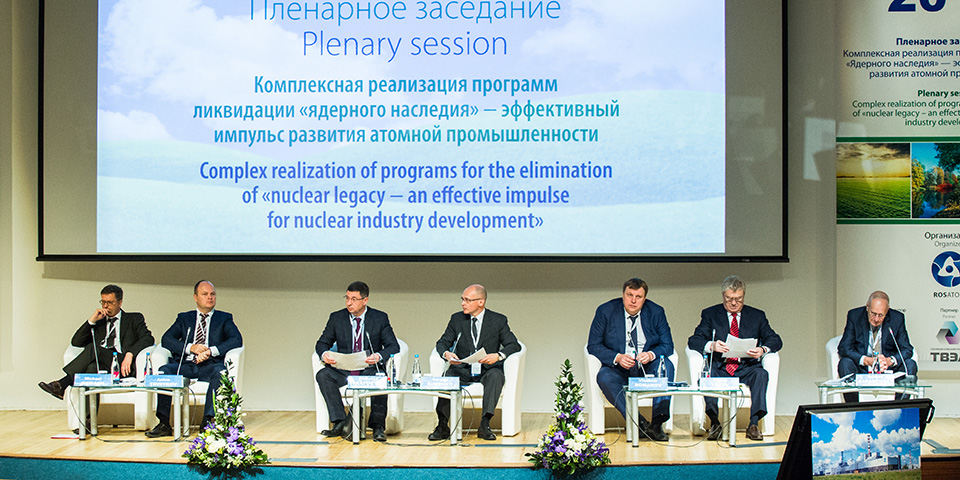
Safety discussed at AtomEco
back to contentsOpening the plenary session, Sergei Baranovsky, Deputy Chairman of Rosatom’s Public Council, noted, “AtomEco exhibition and conference is a long established venue for Russian and foreign experts to meet and discuss end-of-cycle and nuclear decommissioning solutions. The forum is dedicated to this year’s central event – completion of the Nuclear and Radiation Safety 2015 Federal Target Program (NRS-1) – and discussion of its results to be incorporated, among other things, in the new radiation safety program for 2016–2030, whose concept has been already approved by the Government. Importance of the program is underlined by a host of federal authorities involved.”
Speaking at the conference, Rosatom CEO Sergei Kirienko told the audience about particular results of the nuclear and radiation safety programs, “What we did in recent years – turning the tide in nuclear safety – was only possible as a joint effort.” He drew the audience’s attention to the fact that NRS-1 targets were exceeded by more than 8% despite a 6% budget cut.
NRS-1 addressed the most urgent nuclear safety issues that had existed just a few years before. One of them was almost no available capacity in spent nuclear fuel (SNF) storage facilities. Now their utilization level is reduced almost twofold, down to 46%. Lake Karachay, the largest open-air SNF storage pool, is out of operation. As reported by Dmitri Kolupaev, Mayak Deputy CEO, the lake will be totally filled with earth by 26 November. According to Sergei Kirienko, the deactivation process is closely monitored, with both SNF seepage and underground conditions kept under control.
As part of NRS-1, B-2 spent fuel pool was put out of operation at the Siberian Chemical Plant (SCP) in Seversk. The first decommissioning phase was completed at another storage pool B-1, says Andrei Samoilov, chief radiation hazard expert with the Russian Academy of Sciences Nuclear Safety Institute. According to him, sample solutions developed for the decommissioning of these pools will be used at other similar facilities within the NRS-2 framework.
Extensive modifications were made in the safety system of the Techa reservoir cascade dam (Chelyabinsk Region). Even the slightest possibility of a dam failure is now excluded, and no effluents are discharged in the Techa River anymore. In addition, a radiation monitoring and emergency response system is being developed in the region.
An unprecedented project was successfully completed at SCP as part of NRS-1. Its goal was to mothball the EI-2 uranium-graphite reactor that used to fabricate weapons-grade plutonium. “We are the first to have developed a decommissioning technology for uranium-graphite reactors that guarantees more than a thousand years of safe storage. This technology enables us to mothball 12 remaining reactors,” Kirienko said.
The pioneer in the field is the Pilot Decommissioning Center for Uranium-Graphite Reactors. The pilot center was established in 2010 at SCP to develop standardized nuclear decommissioning technologies. This aspect had never been addressed before – research and development were started from scratch, and so was the new regulatory framework. Technologies were developed in close cooperation with leading R&D institutions affiliated with the Russian Academy of Sciences. Investments in the project amounted to 2.3 billion rubles.
Launched in 2012, the project was completed in September 2015. Within just three years, the reactor and adjacent area were fully covered with a barrier material, which is a graphite layer with 22 meters of earth underneath and 12 meters above. This effort required more than 40,000 cubic meters of special clay. In addition, more than 11,000 cubic meters of aboveground structures were decontaminated and disassembled to be subsequently sorted, packed and placed in temporary storage.
In fact, the EI-2 decommissioning project is a new step in the nuclear industry development. Since it is a success both in terms of environmental safety and business, the technology can be used abroad where efficient decommissioning solutions capable of returning the site to greenfield status are in high demand.
According to Rosatom CEO, NRS-1 turned the tide in the nuclear environmental safety. An extended report will be issued on program results, says Andrei Samoilov. It will be drafted later this year and updated with events scheduled for the end of 2015. The final version will be released in the first half of 2016.
“Closing NRS-1, we are now moving to NRS-2, which has other goals than preventing nuclear disasters. These goals were achieved with the first program. As for NRS-2, it will target the transfer of decommissioned facilities from controlled to ultimately safe status, their subsequent liquidation, development of the full-fledged infrastructure and terminal isolation of all the accumulated radioactive waste. The program will be in effect till 2030, divided into three 5-year phases,” explained Sergei Kirienko.
Russia’s extensive effort in maintaining nuclear and radiation safety is recognized on the global scale. “We are impressed with professionalism exhibited by Russian experts,” Michael Siemann, Head of the OECD NEA Division of Radiological Protection and Radioactive Waste Management, admitted in his speech at AtomEco-2015. “I hope that NEA member countries will extend their cooperation with Russia and work out joint approaches to decommissioning and radioactive waste management to facilitate the nuclear industry development.”




